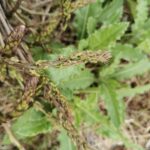
Wild Edible Greens
Wild greens are various types of edible green plants, which grow in abundance around the fields, meadows and roadsides of Hvar. As many of them have a bitter taste, they are also called ‘bitter greens’. The islanders classify them as weeds, because, by definition, they are not cultivated. They are at their best as autumn gives way to winter, right through to early spring, so they are a good source of vitamins at the time when ‘flu and colds tend to be at their most virulent. Once they start to flower, they are no longer edible. On Hvar wild greens are cooked in boiling water, and served as a salad dressed with olive oil.
Bitter tasting and health-giving
The majority of these plants belong to the asteraceae (compositae) family, such as dandelions, wild chicory, goat’s beard (tragopogon), sow thistle (sonchus oleraceus), rattlesnake root (prenanthes), common reichardia (reichardia picroides). Other wild greens are often sweeter in taste, such as young poppy, wild garlic, wild carrot, wild fennel and common purslane.
In past times, a good knowledge of self-seeding wild plants was crucial for survival, when other foodstuffs were scarce or unaffordable. Nowadays the fine, bitter, slightly metallic earthy taste of wild greens, together with olive oil, is prized as the ideal side-dish with fish. The greens can be combined with boiled potatoes or hard-boiled eggs, and are considered a staple of the ideal Mediterranean diet.
Wild asparagus
In early spring, wild asparagus is a much sought-after delicacy on Hvar. It can be found at the edges of woodlands and among low-lying shrubs, and is picked at the time when this prickly, tough-leaved plant is sprouting. As the asparagus plants are slim and often concealed among other wild plants, it is difficult to spot for the uninitiated. Locations where the wild asparagus grows in abundance are often a closely guarded secret, with islanders jealously protecting their own ‘patch’ against intruders.
Wild asparagus can be eaten raw in a salad, or prepared in a variety of ways. The simplest recipe is to blanch the asparagus and serve it as a salad with hard-boiled eggs or an omelette. Other uses include as an ingredient in pasta sauces, adding them to risotto, serving them with salt-cured pork (bacon) or other types of meat.
It has long been known that asparagus helps kidney function, influencing the elimination of excess fluids from the body, and generally assisting cleansing of the system. It is rich in vitamins, minerals and fibre. The plant likes a mixture of sun and shade, as well as damp places alongside woodland paths and old stone walls. Hvar’s wild asparagus is noticeably slimmer and a darker green than cultivated varieties. As it grows from a tuber, it self-renews readily after harvesting or fire damage. Only the young tender shoots are picked, which emerge in the spring from their origins underground as warm weather arrives, especially after rain.
All the world’s ancient nations were familiar with asparagus, and it was believed to be an aphrodisiac.
Samphire
Samphire (crithmum maritimum) is a plant which grows in fissures in coastal rocks. It thrives in very poor saline soil, and loves being dowsed in salty spray and needs a lot of sunshine. Its young shoots and leaves are harvested in May and June, before it flowers. They are marinated in wine vinegar and eaten with fish or meat.
The samphire flower growing out of rocks was featured in the Greek myth of Poseidon’s illicit love affair with Zeus’ beloved nymph Dahomar. The lovers are said to have lain together by the sea on samphire which grew from Poseidon’s semen out of the rocks.
Capers

Capers (capparis spinosa) also grow out of stones, and green clumps of this self-seeding bushy plant are a common sight on Hvar growing on old stone houses, stone mounds and rockeries. Capers bloom from April to September, when fragrant white flowers pale pink stamens arise from the axils of their leaves. The caper buds are harvested, and are mainly used as a garnish for the traditional Dalmatian starter of cheese, smoked ham, sausages and salami. They are excellent eaten with fillets of salted fish and black olives, seasoned with olive oil. They are also used for sauces, various meat and fish dishes, risotto and pizza, and they go well with mustard and horseradish.
Hvar’s Renaissance poet Petar Hektorović mentioned capers in his ‘Fishing and Fishermen’s Tales’ (1556), which shows that capers have been eaten on the island for many centuries.







